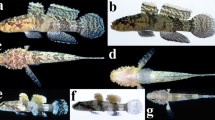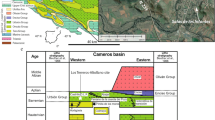Abstract
Peramelemorphians (bandicoots and bilbies) are unique among mammals in having the shortest gestation period. Very little is known about their evolutionary history primarily because until recently their fossil record was scarce. Here we describe two new species, Madju variae, gen. et sp. nov., from late Oligocene to middle Miocene deposits from the Riversleigh World Heritage Area, Queensland, and the Kutjamarpu Local Fauna, South Australia, and Madju encorensis, gen. et sp. nov., also from Riversleigh WHA but from the late middle to early late Miocene. Phylogenetic analysis suggests that they are best regarded as basal members of the Superfamily Perameloidea. Species of Madju are unusual in showing a distinct reduction in size through time, possibly reflecting environmental change from the early to late Miocene. Madju variae is the first-known sexually dimorphic fossil peramelemorphian. The preservation and representation of specimens of M. variae is exceptional, enabling documentation of ontogenetic development from juvenile to old adult stage suggesting that juveniles of M. variae developed more slowly than their modern counterparts and that lactation lasted for a longer time. If so, the short gestation of modern peramelemorphians would appear to be a specialisation that might have evolved sometime after the middle Miocene.













Similar content being viewed by others
References
Aplin KP, Archer M (1987) Recent advances in marsupial systematics with a new syncretic classification. In: Archer M (ed) Possums and Opossums: Studies in Evolution, Volume 1. Surrey Beatty & Sons, Sydney, pp xv-lxxii
Aplin KP, Helgen KM, Lunde DP (2010) A review of Peroryctes broadbenti, the giant bandicoot of Papua New Guinea. Am Mus Novitates 3696:1–41
Archer M (1976) The dasyurid dentition and its relationships to that of didelphids, thylacinids and borhyaenids. Australian J Zool, Suppl Ser 39:1–34
Archer M, Arena DA, Bassarova M, Beck RMD, Black K, Boles WE, Brewer P, Cooke BN, Crosby K, Gillespie A, Godthelp H, Hand SJ, Kear BJ, Louys J, Morrell A, Muirhead J, Roberts KK, Scanlon JD, Travouillon KJ, Wroe S (2006) Current status of species-level representation in faunas from selected fossil localities in the Riversleigh World Heritage Area, northwestern Queensland. Alcheringa Spec Iss 1:1–17
Archer M, Hand SJ, Godhelp H (1994) Patterns in the history of Australia's mammals and inferences about palaeohabitats. In: Hill R (ed) History of the Australian Vegetation. Cambridge University Press, Cambridge, pp 80–103
Archer M, Hand SJ, Godhelp H (1995) Tertiary environmental and biotic change in Australia. In: Vrba ES, Denton GH, Partridge TC, Burckle LH (ed) Paleoclimate and Evolution, with Emphasis on Human Origins. Yale University Press, New Haven, pp 77–90
Archer M, Hand SJ, Godthelp H, Creaser P (1997) Correlation of the Cainozoic sediments of the Riversleigh World Heritage fossil property, Queensland, Australia. In: Aguilar J-P, Legendre S, Michaux J (ed) Actes du congrès BiochroM'97, Mémoires et Travaux de l'Ecole Pratique des Hautes Etudes,Institut de Montpellier 21:131–152
Arena DA (2004) The geological history and development of the terrain at the Riversleigh World Heritage Area during the middle Tertiary. Ph.D. Dissertation, University of New South Wales, Sydney
Beck RMD (2008) A dated phylogeny of marsupials using a molecular supermatrix and multiple fossil constraints. J Mammal 89(1):175–189
Beck RMD, Godhelp H, Weisbecker V, Archer M, Hand SJ (2008) Australia's oldest marsupial fossils and their biogeographical implications. PloS ONE 3(3):e1858
Black KH, Archer M, Hand SJ, Godthelp H (2010) First comprehensive analysis of cranial ontogeny in a fossil marsupial—from a 15-million-year-old cave deposit in northern Australia. J Vertebr Paleontol 30(4):993–1011
Black KH, Archer M, Hand SJ, Godthelp H (2013a) Revision in the diprotodontid marsupial genus Neohelos: systematics and biostratigraphy. Acta Palaeontol Polonica 58(4):679–706
Black KH, Louys J, Price GJ (2013b) Understanding morphological variation in the extant koala as a framework for identification of species boundaries in extinct koalas (Phascolarctidae; Marsupialia). J Syst Palaeontol doi:DOI:10.1080/14772019.2013.768304
Brammall J, Archer M (1997) A new Oligocene-Miocene species of Burramys (Marsupialia. Burramyidae) from Riversleigh. northwestern Queensland. Mem Queensland Mus 41(2):247–268
Flannery T (1995) Mammals of New Guinea. Reed Books, Australia
Flores DA, Abdala F, Giannini NP (2013) Post-weaning cranial ontogeny in two bandicoots (Mammalia, Peramelemorphia, Peramelidae) and comparison with carnivorous marsupials. J Zool 116:372–384 doi:http://dx.doi.org/10.1016/j.zool.2013.07.003
Gillespie AK (2007) Diversity and systematics of marsupial lions from the Riversleigh World Heritage Area and the evolution of the Thylacoleonidae. Ph.D. Dissertation, University of New South Wales, Sydney
Godthelp H, Archer M, Hand SJ, Plane MD (1989) New potoroine from Tertiary Kangaroo Well Local Fauna, N.T. and description of upper dentition of potoroine Wakiewakie lawsoni from Upper Site Local Fauna, Riversleigh. In: 5th Conference on Australian Vertebrate Evolution, Palaeontology and Systematics, Abstracts, Sydney. University of New South Wales, p 6
Gordon G, Hulbert AJ (1989) Peramelidae. In: Walton DW (ed) Fauna of Australia vol Vol. 1B: Mammalia. Australian Government Publishing Service, Canberra, pp 603–624
Gurovich Y, Travouillon KJ, Beck RMD, Muirhead J, Archer M (2013) Biogeographical implications of a new mouse-sized fossil bandicoot (Marsupialia: Peramelemorphia) occupying a dasyurid-like ecological niche across Australia. J Syst Palaeontol doi:10.1080/14772019.2013.776646
Johnson C, Johnson KA (1983) Behaviour of the Bilby, Macrotis lagotis (Reid) in captivity. Australian Wildl Res 10:77–87
Johnson KA (1989) Thylacomyidae. In: Walton DWE (ed) Fauna of Australia. Australian Government Publishing Service, Canberra, pp 625–635
Kingsmill E (1962) An investigation of criteria for estimating age in the marsupials Trichosurus vulpecula Kerr and Perameles nasuta Geoffroy. Australian J Zool 10:597–616
Lewis PO (2001) A likelihood approach to inferring phylogeny from discrete morphological characters. Syst Biol 50:913–925
Louys J, Black K, Archer M, Hand SJ, Godhelp H (2007) Descriptions of koala fossils from the Miocene of Riversleigh, northwestern Queensland and implications for Litokoala (Marsupialia, Phascolarctidae). Alcheringa 31:99–110
Luckett WP (1993) An ontogenetic assessment of dental homologies in therian mammals. In: Szalay FS, Novacek MJ, McKenna MC (eds) Mammal Phylogeny: Mesozoic Differentiation, Multituberculates, Monotremes, Early Eutherians and Marsupials. Springer-Verlag, New York, pp 182–204
Lyne AG, Mort PA (1981) A comparison of skull morphology in the marsupial bandicoot genus Isoodon: its taxonomic implications and notes on a new species, Isoodon arnhemensis. Australian Mammal 4:107–133
McCraken HE (1990) Reproduction in the Greater Bilby, Macrotis lagotis (Reid) - a comparison with other perameloids. In: Seebeck JH, Brown PR, Wallis RL, Kemper CM (eds) Bandicoots and Bilbies. Surrey Beatty & Sons, Sydney, pp 199–204
Megirian D, Prideaux GJ, Murray PF, Smit N (2010) An Australian land mammal age biochronological scheme. Paleobiology 36:658–671
Meredith RW, Westerman M, Springer MS (2008) A timescale and phylogeny for "bandicoots" (Peramelemorphia: Marsupialia) based on sequences for five nuclear genes. Mol Phylogen Evol 47:1–20
Muirhead J (1994) Systematics, evolution and palaeobiology of recent and fossil bandicoots (Peramelemorphia, Marsupialia). Ph.D. Dissertation, University of New South Wales, Sydney
Muirhead J (2000) Yaraloidea (Marsupialia, Peramelemorphia), a new superfamily of marsupial and a description and analysis of the cranium of the Miocene Yarala burchfieldi. J Paleontol 74(3):512–523
Muirhead J, Filan SL (1995) Yarala burchfieldi, a plesiomorphic bandicoot (Marsupialia, Peramelemorphia) from Oligo-Miocene deposits of Riversleigh, northwestern Queensland. J Paleontol 69(1):127–134
Roberts KK, Archer M, Hand SJ, Godhelp H (2009) New Australian Oligocene to Miocene ringtail possums (Pseudocheiridae) and revision of the genus Marlu. Palaeontology 52(2):441–456
Roberts KK, Bassarova M, Archer M (2008) Oligo-Miocene ringtail possums of the genus Paljara (Pseudocheiridae: Marsupialia) from Queensland, Australia. Geobios 41:833–844
Simpson G, Roe A, Lewontin R (1960) Quantitative Zoology. Harcourt Brace, New York.
Sorenson MD, Franzosa EA (2007) Treerot ver. 3.0. Department of Biology BU, Boston, MA
Strahan R (1995) The Mammals of Australia. Reed New Holland, Sydney
Swofford DL (2002) PAUP*. Phylogenetic Analysis Using Parsimony (*and Other Methods). Version 4 (updated to 10 beta). Sinauer Associates, Sunderland, Massachussets
Travouillon KJ (2008) Palaeoecological and biochronological studies of Riversleigh, World Heritage Property, Oligo-Miocene Fossil Localities, North-Western Queensland, Australia. Ph.D. Dissertation, University of New South Wales, Sydney
Travouillon KJ, Beck RMD, Hand SJ, Archer M (2013b) The oldest fossil record of bandicoots (Marsupialia; Peramelemorphia) from the late Oligocene of Australia. Palaeontol Electron 16(2):13A 52p
Travouillon KJ, Archer M, Hand SJ, Godthelp H (2006) Multivariate analyses of Cenozoic mammalian faunas from Riversleigh, north-western Queensland. Alcheringa Spec Iss 1:323–349
Travouillon KJ, Gurovich Y, Archer M, Hand SJ, Muirhead J (2013a) The genus Galadi: three new bandicoots (Marsupialia, Peramelemorphia) from Riversleigh’s Miocene deposits, northwestern Queensland, Australia. J Vertebr Paleontol 33(1):153–168
Travouillon KJ, Escarguel G, Legendre S, Archer M, Hand SJ (2011) The use of MSR (Minimum Sample Richness) for sample assemblage comparisons. Paleobiology 37(4):696–709
Travouillon KJ, Gurovich Y, Beck RMD, Muirhead J (2010) An exceptionally well-preserved short-snouted bandicoot (Marsupialia; Peramelemorphia) from Riversleigh's Oligo-Miocene deposits, Northwestern Queensland, Australia. J Vertebr Paleontol 30(5):1528–1546
Travouillon KJ, Legendre L, Archer M, Hand S (2009) Palaeoecological analyses of Riversleigh's Oligo-Miocene sites: implications for Oligo-Miocene climate change in Australia. Palaeogeogr, Palaeoclimatol, Palaeoecol 276(1–4):24–37
Turnbull WD, Lundelius EL Jr, Archer M (2003) Dasyurids, perameloids, phalangeroids, and vombatoids from the early Pliocene Hamilton fauna, Victoria, Australia. Bull Am Mus Nat Hist 279:513–540
Voss RS, Jansa SA (2003) Phylogenetic studies on didelphid marsupials II. Nonmolecular data and new IRBP sequences: separate and combined analyses of didelphine relationships with denser taxon sampling. Bull Am Mus Nat Hist 276:1–82
Westerman M, Kear BP, Aplin K, Meredith RW, Emerling C, Springer MS (2012) Phylogenetic relationships of living and recently extinct bandicoots based on nuclear and mitochondrial DNA sequences. Mol Phylogen Evol 62:97–108 doi:10.1016/j.ympev.2011.09.009
Westerman M, Krajewski C (2000) Molecular relationships of the Australian bandicoot genera Isoodon and Perameles (Marsupialia: Peramelina). Australian Mammal 22:1–8
Westerman M, Springer MS, Dixon J, Krajewski C (1999) Molecular relationships of the extinct pig-footed bandicoot Chaeropus ecaudatus (Marsupialia: Perameloidea) using 12S rRNA sequences. J Mammal Evol 6:271–288
Westerman M, Springer MS, Krajewski C (2001) Molecular relationships of the New Guinean bandicoot genera Microperoryctes and Echymipera (Marsupialia: Peramelina). J Mammal Evol 8:93–105
Wible JR (2003) On the cranial osteology of the short-tailed opposum Monodelphis brevicaudata (Didelphidae, Marsupialia). Ann Carnegie Mus 72(3):137–202
Woodburne MO, MacFadden BJ, Case JA, Springer MS, Pledge N, Power JD, Woodburne J, Springer KB (1993) Land mammal biostratigraphy and magnetostratigraphy of the Etadunna Formation (late Oligocene) of South Australia. J Vertebr Paleontol 13:483–515
Worthy TH, Tennyson AJD, Archer M, Musser AM, Hand SJ (2006) Miocene mammal reveals a Mesozoic ghost lineage on insular New Zealand, southwest Pacific. Proc Natl Acad Sci USA 103:19419–19423
Acknowledgments
Support for research at Riversleigh has come from the Australian Research Council (LP0989969, LP100200486, DP1094569 & DP130100197 grants to M. Archer and S.J. Hand at the University of New South Wales); XSTRATA Community Partnership Program (North Queensland); the University of New South Wales; P. Creaser and the CREATE Fund; the Queensland Parks and Wildlife Service; Environment Australia; the Queensland Museum; the Riversleigh Society Inc.; Outback at Isa; Mount Isa City Council; private supporters including K. & M. Pettit, E. Clark, M. Beavis, and M. Dickson; and the Waanyi people of northwestern Queensland. Assistance in the field has come from many hundreds of volunteers as well as staff and postgraduate students of the University of New South Wales. We thank R. Day for providing funding to the University of Queensland to create a postdoctoral position for K. J. Travouillon. We thank S. Ingleby and A. Divljan from the Australian Museum, H. Janetzki from the Queensland Museum, and C. Stevenson from the Western Australian Museum for providing access to modern bandicoot specimens. We thank the UNSW Palaeosciences Lab and the UQ Palaeo Hub for their support and anonymous reviewers for helpful comments.
Author information
Authors and Affiliations
Corresponding author
Rights and permissions
About this article
Cite this article
Travouillon, K.J., Archer, M., Hand, S.J. et al. Sexually Dimorphic Bandicoots (Marsupialia: Peramelemorphia) From the Oligo-Miocene of Australia, First Cranial Ontogeny for Fossil Bandicoots and New Species Descriptions. J Mammal Evol 22, 141–167 (2015). https://doi.org/10.1007/s10914-014-9271-8
Published:
Issue Date:
DOI: https://doi.org/10.1007/s10914-014-9271-8




